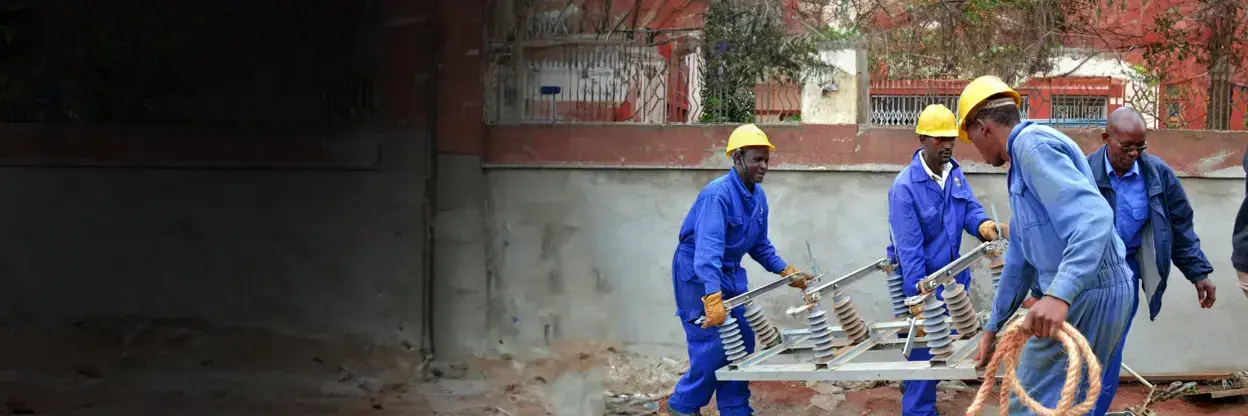
Electrification Project
Background.
Over the last 10 years the country has seen a steady growth in electricity connections both in urban and rural areas which has been driven by a combination of various factors, chief among them being the incoming of a new political dispensation in 2002. The new government demanded that the company accelerate connectivity hence called for a totally new approach in the connectivity model within KPLC.
In 2004, a new connection policy was developed to address this new challenge and also take cognisance of the more enlightened customer. In it, among other things, the cost of connecting customers on low voltage network who were within 600m of a distribution transformer was standardized for single phase and three phase to a minimum of KShs. 32,480 and KShs. 44,080 respectively (between 3 and 8KVA, including connection charges @ KShs. 1000/= per KVA, VAT inclusive.
In order to accelerate the connectivity rate and achieve annual connections in the range of 1.3 million, it was proposed that a new model be adopted that will help overcome the current bottlenecks in the connectivity pipeline. This new model focuses on availing the service connection including the meter to the customer premises prior to engaging the customer to pay for the service.
To benefit from this project, customers within range of selected transformers will be required to contribute a total of KShs.15, 000 for each single phase connection. However the beneficiaries will be allowed to pay in instalment for a period of up to a maximum of 36 months.
Activities such as way leaves acquisitions, permits and approvals will be sought from the County Governments and other relevant authorities prior to connection of the supply.
Among the results of this new model is Last Mile Connectivity Project funded by;
- African Development Fund (ADF).
- IDA
This project aims at increasing electricity access to Kenyans, particularly the low income groups. It is envisaged that this will result in accelerated economic growth at the micro-economic level in line with the Government’s vision 2030 by having universal access by the year 2020.
Brief description of ADF funded project.
The Government of Kenya received funding from African Development Fund amounting to KShs.13.5 Billion to enable it stimulate economic growth and accelerate job creation to improve the economic wellbeing of Kenyans in line with vision 2030 strategic plan. Among the many interventions to achieve this is expansion of the power distribution system to be within reach and thus enable more Kenyans connect to the grid at an affordable cost and hence initiate economic activities at the micro - economic level.
This will be achieved by extending the low voltage network on existing and other upcoming distribution transformers to reach households lying within transformer protection distance. The first phase will involve extension of low voltage network which entails construction of 12,000 kilometres of low voltage distribution lines, installation of equipment for the connection of 284,200 residential customers and 30,000 commercial customers. It is envisaged that an estimated 314,200 customers will be connected across all counties in a period of 18 Months.
By connecting the 314,200 households will result in over 1,571,000 Kenyans accessing power.
In this regard, Kenya Power has identified 5,320 transformers located in the 47 counties for the implementation of the first phase of the project with design scheduled to begin in September 2015, while the actual construction is scheduled to begin within three months of completion of the Design Works.
Selection of the distribution transformers for the Last Mile project was based on the Government Constituency Development Fund criteria for resource allocation. To enhance regional balance where some constituencies don’t have enough transformers, their allocation was distributed within the same county.
Brief description of IDA funded project.
This Project will finance the design, materials and construction works required to electrify all households and businesses in selected high density peri urban areas located close to existing electricity networks at an estimated cost of US$153.5 Million.
The peri-urban settlements to be electrified will be in approximately 50 locations in seven geographical regions of the country. The locations were identified by KPLC and endorsed by the government. These will be formal settlements of low income households i.e., not informal settlements (slums). The actual settlement sites will be selected during design of the low voltage networks based on population density and their location close to existing electricity networks, in order to maximize the number of connections. In these geographic areas the Project would “sweep” the areas under the installed MV lines by Maximizing on the existing transformers, addition of new transformers, Low Voltage (LV) network and some MV lines.
The Project will comprise;
- Construction of about 300 km of MV lines;
- Installation of 1,000 distribution transformers;
- Construction of about 12,500 km of single phase LV lines, 125,000No. service cables and installation of 200,000 energy meters to the respective households.
- Procurement of Materials for connection of the new customers to grid supply.
It is estimated that a total of 125,000 new households will be connected to grid supply under this Project translating to an overall electricity access to 1.5Million Kenyans.
Expectation and Impacts
a. Improved living standard for Kenyans.
Those who will be connected will enjoy clean lighting compared to kerosene lamps that generate hazardous fumes. This will lead to improved healthy nation reducing the burden on our hospitals
b.Job creation to Kenyans.
Since the project is being implemented concurrently in all counties it will demand a lot of labour hence generating jobs for large number of youths.
c.Improved security
Communities that were once covered in darkness when the sun went down will now be lit up this will reduce crime, increase productive man hours and generally promote communities wellbeing.
d.Better access to information and communication.
Television and other internet connected devices i.e. mobile phones will improve access to information, the ability to study, and extend the effective working day. This is more so because children can have extended time of study.
Reduction of carbon emissions hence saving our environment by reducing burning of carbon based fuels.
eProcurement
Downloads

USSD

National Contact Center

Support Email

Kolobot Rd

P.O. BOX
© 2025 - Kenya Power. All rights reserved.







